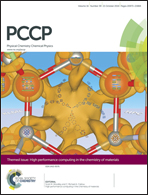On the structure of Ce-containing silicophosphate glasses: a core–shell molecular dynamics investigation†
Abstract
Classical molecular dynamics simulations have been used to investigate the local and medium range structure of Ce-containing silicophosphate glasses widely used in optical and photonic devices because of their enhanced UV absorption and radiation damage resistance properties. New Ce3+–O and Ce4+–O parameters for a force-field based on the core–shell model were developed by fitting on the crystalline structures of Ce-containing crystal phases, and used to get insights into the structure of five silicophosphate glasses with increasing Ce2O3 and P2O5 content. An excellent agreement between experimental and computational data was found for the local environment around cerium ions and network former cations. The Ce3+–O bond lengths are generally longer than Ce4+–O, which shows higher coordination numbers. Both P and Si are four-fold coordinated; their allocation in the network is not uniform: the increasing Ce content leads to the formation of silica-rich domains and phosphate-rich domains, which entrap Ce cations increasing their solubility in the glass. We found that both the Qn distributions of phosphorous and Ce clustering depend on the Ce/P ratio in the glass. In particular, Ce clustering begins for Ce/P ratios between 0.17 and 0.29 in the glass series investigated.


 Please wait while we load your content...
Please wait while we load your content...